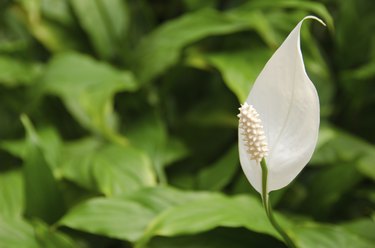
Although it's often grown as a houseplant, all types of peace lily (Spathiphyllum spp.) have a dark side. Parts of the plant contain oxalate crystals, which are toxic if eaten and can also cause skin irritation. Be careful if you're growing this plant around curious children or pets as the peace lily is not child safe. Peace lilies are hardy in U.S. Department of Agriculture zones 11 and 12, advises Missouri Botanical Garden.
Peace Lily Toxicity
Video of the Day
Peace lily contains a chemical irritant, called calcium oxalate crystals, in the stems and leaves. If a person or pet eats parts of the peace lily, these sharp crystals affect the sensitive mouth, gums and throat much the same way as chewing on ground glass. This causes pain, swelling and difficulty swallowing. The juices can also irritate skin and cause burning, pain and swelling.
Video of the Day
Although the peace lily is toxic to babies and children, severe poisoning from plants like peace lily is rare, because the discomfort from eating leaves makes children spit them out quickly, advises the Children's Hospital of Philadelphia. If your child does eat part of a peace lily, wipe as much as you can out of his mouth and give him a cool drink or snack to ease the pain. If the pain is accompanied by swelling that causes difficulty breathing, swallowing or talking, take your child to the nearest emergency room immediately.
Reasons to Grow a Peace Lily
Despite of the potential danger a peace lily poses, it's still a good choice as a houseplant. Peace lily is considered one of the top 10 houseplants for cleaning the air, and it is simple to grow and maintain.
If you keep the plant out of the reach of children and pets, or only grow it after the child is old enough to avoid eating the leaves, a peace lily makes a fine addition to a houseplant collection. However, if you have young children or pets, it may be safer to select non-toxic plants to grow in your home.
Best Growing Conditions
Most varieties you will see in stores are cultivated hybrids, like the dwarf peace lily (Spathiphyllum x "Wallisii"), hardy in USDA zones 10B and 11, advises the University of Florida IFAS Extension. When growing a peace lily in a container, a general-purpose potting mix works well. Always use a pot with drainage holes. Outdoors, choose a spot in the shade with fertile soil rich in organic matter.
A peace lily will grow best in temperatures between 68 and 85 degrees Fahrenheit during the day, and a drop in temperature of about 10 F at night. Through the plant likes warmth, direct sun will burn the leaves. Bright, filtered light is best.
Caring for a Peace Lily
A peace lily is sensitive to salinity, so make sure you use a fresh water source. For an indoor peace lily, let the top of the potting mix dry between waterings. The goal is to keep the soil moist, but not soggy. Use water that is at room temperature.
A peace lily doesn't need much fertilizer. Use a liquid houseplant food at one-half the usual strength. For an all-purpose concentrated fertilizer with an N-P-K ratio of 12-4-8, this means mixing 1/2 teaspoon in 1 gallon of water and applying to the soil every seven to 14 days. Check the label as dilution rates vary among brands.
Wear gloves whenever handling a peace lily, especially if you have sensitive skin. If you or a child gets the juice from a peace lily on your skin, wash several times with soap and warm, running water.